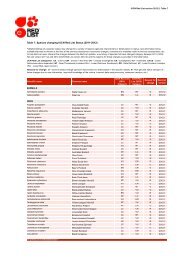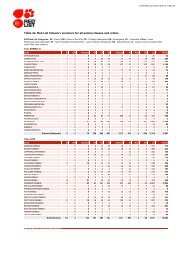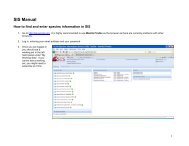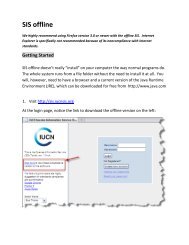IUCN Red List Guidelines - The IUCN Red List of Threatened Species
IUCN Red List Guidelines - The IUCN Red List of Threatened Species
IUCN Red List Guidelines - The IUCN Red List of Threatened Species
Create successful ePaper yourself
Turn your PDF publications into a flip-book with our unique Google optimized e-Paper software.
<strong>Red</strong> <strong>List</strong> <strong>Guidelines</strong> 18<br />
3.2.3 Dispute tolerance and risk tolerance<br />
When interpreting and using uncertain data, attitudes toward risk and uncertainty are<br />
important. First, assessors need to consider whether they will include the full range <strong>of</strong><br />
plausible values in assessments, or whether they will exclude extreme values from<br />
consideration (known as dispute tolerance). Uncertainty in the data is reduced when an<br />
assessor has a high dispute tolerance, and thus excludes extreme values from the assessment.<br />
We suggest assessors adopt a moderate attitude, taking care to identify the most likely<br />
plausible range <strong>of</strong> values, excluding extreme or unlikely values.<br />
Second, assessors need to consider whether they have a precautionary or evidentiary attitude<br />
to risk (known as risk tolerance). A precautionary attitude (i.e., low risk tolerance) will<br />
classify a taxon as threatened unless it is highly unlikely that it is not threatened, whereas an<br />
evidentiary attitude will classify a taxon as threatened only when there is strong evidence to<br />
support a threatened classification.<br />
3.2.4 Dealing with uncertainty<br />
It is recommended that assessors should adopt a precautionary but realistic attitude, and to<br />
resist an evidentiary attitude to uncertainty when applying the criteria (i.e., have low risk<br />
tolerance). This may be achieved by using plausible lower bounds, rather than best<br />
estimates, in determining the quantities used in the criteria. It is recommended that ‘worst<br />
case scenario’ reasoning be avoided as this may lead to unrealistically precautionary listings.<br />
All attitudes should be explicitly documented. In situations where the spread <strong>of</strong> plausible<br />
values (after excluding extreme or unlikely values) qualifies a taxon for two or more<br />
categories <strong>of</strong> threat, the precautionary approach would recommend that the taxon be listed<br />
under the higher (more threatened) category.<br />
In some rare cases, uncertainties may result in two non-consecutive plausible threat<br />
categories. This may happen, for example, when extent <strong>of</strong> occurrence (EOO) or area <strong>of</strong><br />
occupancy (AOO) is smaller than the EN threshold and one subcriterion is definitively met,<br />
but it is uncertain whether a second subcriterion is also met. Depending on this, the category<br />
can be either EN or NT. In such cases, the category could be specified as the range EN–NT<br />
in the documentation (giving the reasons why), and the assessors must choose the most<br />
plausible <strong>of</strong> the categories, <strong>of</strong> which VU could be one. This choice depends on the level <strong>of</strong><br />
precaution (see section 3.2.3) and should be justified.<br />
Specific guidelines for dealing with uncertainty in assessing taxa with widely distributed or<br />
multiple subpopulations against criterion A are given in section 5.8. This section <strong>of</strong>fers clear<br />
guidance on using uncertain estimates, uncertainty about the pattern <strong>of</strong> population decline<br />
and using data with different abundance units.<br />
3.2.5 Documenting uncertainty and interpreting listings<br />
<strong>The</strong> level <strong>of</strong> uncertainty associated with a particular taxon’s assessment is not apparent from<br />
the listing itself, potentially complicating and de-valuing interpretation <strong>of</strong> listings. When a<br />
plausible range for each quantity is used to evaluate the criteria, a range <strong>of</strong> categories may be






